Fractal Dimensions of Particle Size Distribution in Littoral Sandstones of Carboniferous Donghetang Formation in Hade Oilfield, Tarim Basin, NW China
Abstract
1. Introduction
2. Materials and Methods
2.1. Study Area
2.2. Sampling and Analysis
2.3. Statistical Parameter Calculation
2.4. Fractal Dimension Theory
2.5. Statistical Analysis
3. Results
3.1. Particle Size Compositions
3.2. Traditional Statistical Parameters
3.3. Fractal Dimensions
4. Discussion
4.1. Pearson’s Correlation of All Parameters
4.2. Relationships Between Fractal Dimension and Particle Size Compositions
4.3. Relationships Between Fractal Dimension and Traditional Statistical Parameters
4.4. Relationships Between Fractal Dimension and Sedimentary Facies
5. Conclusions
- (1)
- Littoral sandstones of the Donghetang Formation are divided into fine sandstones and silty sandstones. Mean, sorting, skewness, kurtosis, and fractal dimension values of fine sandstones are mainly 102.49–284.72 μm, 1.45–2.72, −0.46–0.13, 0.89–2.82, and 1.69–2.17, respectively. Those values of silty sandstones are dominantly 28.03–181.99 μm, 1.84–7.54, −0.79–−0.17, 0.56–3.38, and 2.12–2.73, respectively.
- (2)
- In PSDs of fine sandstones and silty sandstones, fractal dimension and sandy content show strong negative linear relationships. Fractal dimension and silty and clayey contents exhibit significant logarithmic relations. Relationships between fractal dimension and mean, sorting, and skewness of silty sandstones are better than those of fine sandstones. Fractal dimension and kurtosis of both sandstones have weak positive and negative linear relationships.
- (3)
- In littoral facies, fractal dimension values in lower-shoreface, 2.05–2.47 averaged at 2.33, are generally higher than that in upper-shoreface, 1.79–2.30 averaged at 2.11. In littoral microfacies, the fractal dimension values in bar and beach are commonly lower than that in trough. Combined with more sedimentary information, the fractal dimension can serve as another new depositional indicator in various clastic deposits.
Author Contributions
Funding
Institutional Review Board Statement
Informed Consent Statement
Data Availability Statement
Acknowledgments
Conflicts of Interest
Abbreviations
| PSD | Particle size distribution |
| GR | Natural gamma ray logging, API |
| Me | Mean value of PSD, μm |
| So | Sorting value of PSD |
| Sk | Skewness value of PSD |
| Ku | Kurtosis value of PSD |
| Ri | Arithmetic mean of the upper and lower limit of the ith particle size level, μm |
| Rmax | Maximum particle size, μm |
| Vi | Cumulative volume of particles smaller than Ri, μm3 |
| VT | Total volume of sediment particles, μm3 |
| D | Volumetric fractal dimension of PSD |
References
- Yuan, R. Progress on mining methods of sedimentological information from grain-size distribution from the background of big data. Acta Sediment. Sin. 2025, 43, 361–375. [Google Scholar] [CrossRef]
- IJmker, J.; Stauch, G.; Dietze, E.; Hartmann, K.; Diekmann, B.; Lockot, G.; Opitz, S.; Wünnemann, B.; Lehmkuhl, F. Characterisation of transport processes and sedimentary deposits by statistical end-member mixing analysis of terrestrial sediments in the Donggi Cona lake catchment, NE Tibetan Plateau. Sediment. Geol. 2012, 281, 166–179. [Google Scholar] [CrossRef]
- Bright, C.; Mager, S.; Horton, S. Response of nephelometric turbidity to hydrodynamic particle size of fine suspended sediment. Int. J. Sediment Res. 2020, 35, 444–454. [Google Scholar] [CrossRef]
- Román-Sánchez, A.; Temme, A.; Willgoose, G.; Berg, D.; Gura, C.M.; Vanwalleghem, T. The fingerprints of weathering: Grain size distribution changes along weathering sequences in different lithologies. Geoderma 2021, 383, 114753. [Google Scholar] [CrossRef]
- Liu, Y.M.; Wang, T.; Liu, B.; Long, Y.L.; Liu, X.X.; Sun, Y.B. Universal decomposition model: An efficient technique for palaeoenvironmental reconstruction from grain-size distribution. Sedimentology 2023, 70, 2127–2149. [Google Scholar] [CrossRef]
- Folk, R.L.; Ward, W.C. Brazos River bar: A study in the significance of grain size parameters. J. Sediment. Petro. 1957, 27, 3–26. [Google Scholar] [CrossRef]
- Cai, G.F.; Fan, D.D.; Shang, S.; Wu, Y.J.; Sha, L. Difference in grain-size parameters of tidal deposits derived from the graphic and its potential causes. Mar. Geol. Quat. Geol. 2014, 34, 195–204. [Google Scholar] [CrossRef]
- Parsons, A.J.; Michael, N.A.; Whittaker, A.C.; Duller, R.A.; Allen, P.A. Grain-size trends reveal the late orogenic tectonic and erosional history of the south–central Pyrenees, Spain. J. Geol. Soc. Lond. 2012, 169, 111–114. [Google Scholar] [CrossRef]
- Gao, S. Grain size trend analysis: Principle and applicability. Acta Sediment. Sin. 2009, 27, 826–836. [Google Scholar] [CrossRef]
- Li, J.L.; He, X.B.; Wei, J.; Bao, Y.H.; Tang, Q.; de Dieu Nambajimana, J.; Nsabimana, G.; Khurram, D. Multifractal features of the particle-size distribution of suspended sediment in the Three Gorges Reservoir, China. Int. J. Sediment Res. 2021, 36, 489–500. [Google Scholar] [CrossRef]
- Qiao, J.B.; Zhu, Y.J.; Jia, X.X.; Shao, M.A. Multifractal characteristics of particle size distributions (50–200 m) in soils in the vadose zone on the Loess Plateau, China. Soil Till. Res. 2021, 205, 104786. [Google Scholar] [CrossRef]
- Armstrong, A.C. On the fractal dimensions of some transient soil properties. J. Soil Sci. 1986, 37, 641–652. [Google Scholar] [CrossRef]
- Tyler, S.W.; Wheatcraft, S.W. Fractal scaling of soil particle-size distributions: Analysis and limitations. Soil Sci. Soc. Am. J. 1992, 56, 362–369. [Google Scholar] [CrossRef]
- Anderson, A.N.; McBratney, A.B.; Crawford, J.W. Applications of fractals to soil studies. Adv. Agron. 1997, 63, 1–76. [Google Scholar] [CrossRef]
- Mohammadi, M.; Shabanpour, M.; Mohammadi, M.H.; Davatgar, N. Characterizing spatial variability of soil textural fractions and fractal parameters derived from particle size distributions. Pedosphere 2019, 29, 224–234. [Google Scholar] [CrossRef]
- Sun, Z.; Ma, X.Z.; Chen, Y.H. Fractal and multifractal characteristics of soil particle-size distribution in different forest types in typical karst regions of Guangxi. Bull. Soil Water Conserv. 2025, 45, 10–19. [Google Scholar] [CrossRef]
- Tahmoures, M.; Honarbakhsh, A.; Afzali, S.F.; Abotaleb, M.; Ingram, B.; Ostovari, Y. Fractal features of soil particles as an indicator of land degradation under different types of land use at the watershed scale in Southern Iran. Land 2022, 11, 2093. [Google Scholar] [CrossRef]
- Mahdi, C.M.; Ghaleno, M.R.D. Evaluating fractal dimension of the soil particle size distributions and soil water retention curve obtained from soil texture components. Arch. Agron. Soil Sci. 2020, 66, 1668–1678. [Google Scholar] [CrossRef]
- Wei, X.; Li, X.G.; Wei, N. Fractal features of soil particle size distribution in layered sediments behind two check dams: Implications for the Loess Plateau, China. Geomorphology 2016, 266, 133–145. [Google Scholar] [CrossRef]
- Liu, Y.D.; Ji, W.J.; Li, Z. Soil fractal characteristics of deep profiles under different vegetation in Loess areas of Northern Shaanxi, China. Res. Soil Water Conserv. 2024, 31, 250–256+264. [Google Scholar] [CrossRef]
- He, Y.; Lv, D. Fractal expression of soil particle-size distribution at the basin scale. Open Geosci. 2022, 14, 70–78. [Google Scholar] [CrossRef]
- He, Y.J.; Peng, B.R.; Dai, L.; Wang, Y.Y.; Liu, Y.; Wang, G.L. The spatial variation of soil structure fractal derived from particle size distributions at the basin scale. Fractal Fract. 2024, 8, 570. [Google Scholar] [CrossRef]
- Yan, L.L.; Song, Y.H. Physical and experimental simulation of unconventional reservoir formation for Carboniferous in Hudson Oilfield, Tarim Basin, China. Front. Earth Sci. 2024, 12, 1430019. [Google Scholar] [CrossRef]
- Zhao, J.W.; Xu, H.M.; He, C.; Jiang, T.W.; Xu, Z.H.; Yang, J.P.; Wang, C.; Yu, Y.C. Control mechanism of sea level rise and fall on the macroscopic heterogeneity of marine reservoirs: An example of the Donghe Sandstone reservoir in the Hadeson Oilfield, Tarim Basin. Geol. Explor. 2017, 53, 590–598. [Google Scholar] [CrossRef]
- Li, J.C.; Chen, Y.Z.; He, H.; Song, H.M.; Xu, J.; Wu, J. Oil and gas distribution in Devonian Donghe Sandstone of Tarim Basin. Xinjiang Petrol. Geol. 2017, 38, 505–511. [Google Scholar] [CrossRef]
- Zhao, J.W.; Xu, H.M.; Jiang, T.W.; He, C.; Xu, Z.H.; Yang, J.P.; Yu, Y.C.; Wang, C. The controlling effect of sea level changing on the microscopic heterogeneity of marine reservoir: Taking shoreface subfacies reservoir of Donghe Sandstone in Hade 4 Oilfield as an example. J. China Univ. Min. Technol. 2018, 47, 1068–1080. [Google Scholar] [CrossRef]
- SY/T 5434-2009; Analysis Method for Particle Size of Clastic Rocks. Oil and Gas Industry Standard of China. National Energy Administration: Beijing, China, 2009.
- Prosperini, N.; Perugini, D. Particle size distributions of some soils from the Umbria Region (Italy): Fractal analysis and numerical modelling. Geoderma 2008, 145, 185–195. [Google Scholar] [CrossRef]
- He, F.; Mohamadzadeh, N.; Sadeghnejad, M.; Ingram, B.; Ostovari, Y. Fractal features of soil particles as an index of land degradation under different land-use patterns and slope-aspects. Land 2023, 12, 615. [Google Scholar] [CrossRef]
- Liu, X.; Zhang, G.C.; Heathman, G.C.; Wang, Y.Q.; Huang, C.H. Fractal features of soil particle-size distribution as affected by plant communities in the forested region of Mountain Yimeng, China. Geoderma 2009, 154, 123–130. [Google Scholar] [CrossRef]
- Deng, J.F.; Wan, L.Y.; Hou, R.P.; Li, J.H.; Wu, B.; Han, M.; Shi, X.L. Soil grain fractal characteristics and soil properties of five forest stand types in the Liaodong Mountains area. J. Northeast For. Univ. 2024, 52, 99–108. [Google Scholar] [CrossRef]
- Fu, X.; Ding, H.; Sheng, Q.; Zhang, Z.; Yin, D.; Chen, F. Fractal analysis of particle distribution and scale effect in a soil–rock mixture. Fractal Fract. 2022, 6, 120. [Google Scholar] [CrossRef]
- Diao, E.L.; Cao, G.C.; Cao, S.K.; Yuan, J.; Tong, S.; Qiu, X.X. Soil particle size and fractal characteristics at different scales. Res. Soil Water Conserv. 2024, 31, 212–220. [Google Scholar] [CrossRef]
- Blott, S.J.; Pye, K. GRADISTAT: A grain size distribution and statistics package for the analysis of unconsolidated sediments. Earth Surf. Process. Landf. 2001, 26, 1237–1248. [Google Scholar] [CrossRef]
- Folk, R.L. The distinction between grain size and mineral composition in sedimentary-rock nomenclature. J. Geol. 1954, 62, 344–359. [Google Scholar] [CrossRef]
- Gao, G.L.; Ding, G.D.; Zhao, Y.Y.; Wu, B.; Zhang, Y.Q.; Qin, S.G.; Bao, Y.F.; Yu, M.H.; Liu, Y.D. Fractal approach to estimating changes in soil properties following the establishment of Caragana korshinskii shelterbelts in Ningxia, NW China. Ecol. Indic. 2014, 43, 236–243. [Google Scholar] [CrossRef]
- Li, W.L.; Xu, H.M.; Gao, S.Y.; Yu, Y.C.; Ning, C.Z.; Yang, J.K.; Jiang, T.W. Inner architectural characteristics of wave-dominated shoreface deposits and their geological implications: A case study of Devonian ‘Donghe Sandstones’ in Tarim Basin, China. Mar. Pet. Geol. 2021, 134, 105334. [Google Scholar] [CrossRef]
- Li, W.L.; Xu, H.M.; Yang, J.K.; Gao, S.Y.; Ning, C.Z.; Yu, Y.C.; Jiang, T.W.; Wan, F.F. Different depositional models of wave-dominated shoreface deposits: An integrated process-oriented analysis (“Donghe Sandstones” in Tarim Basin, China). Mar. Pet. Geol. 2023, 153, 106288. [Google Scholar] [CrossRef]
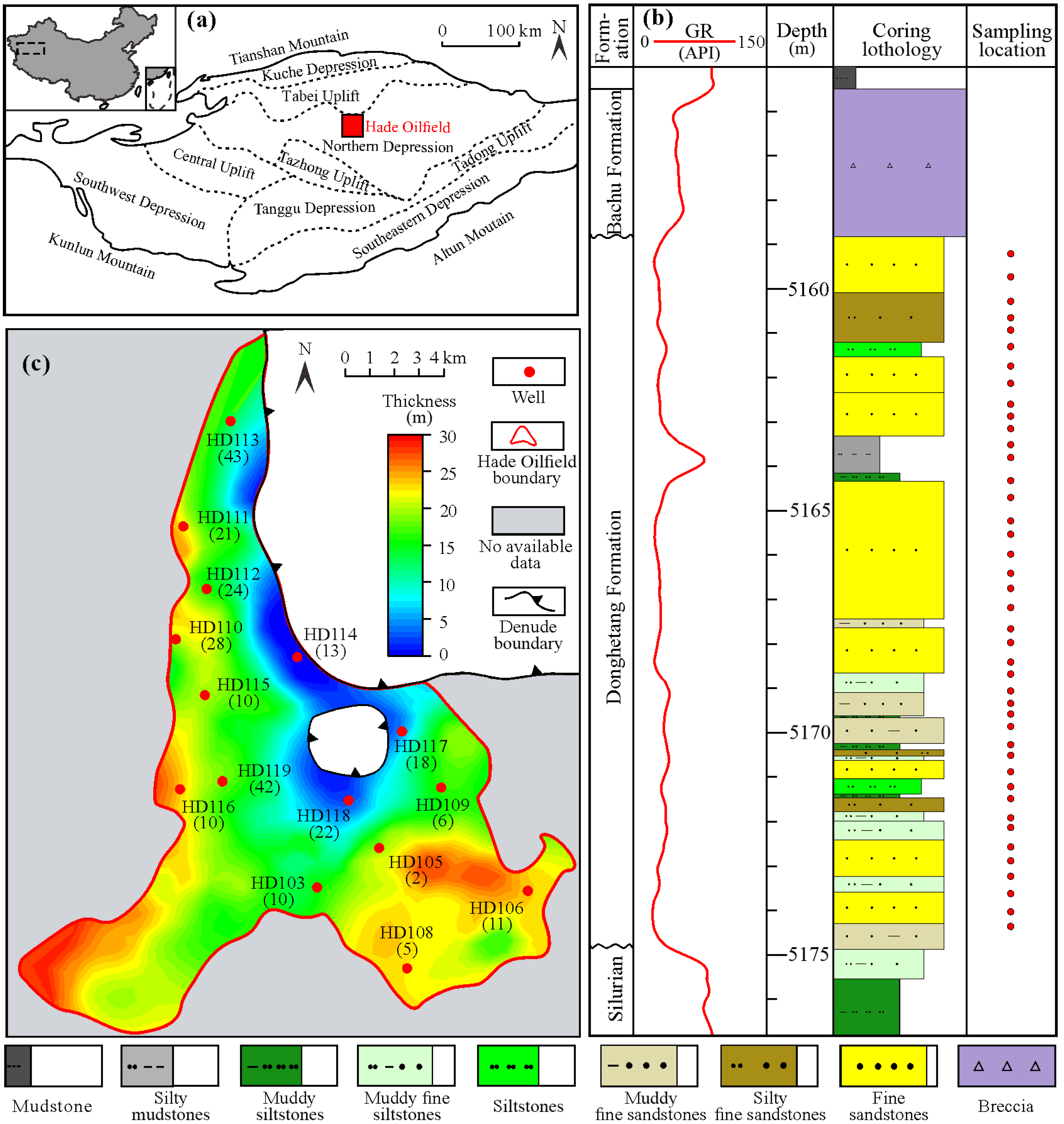
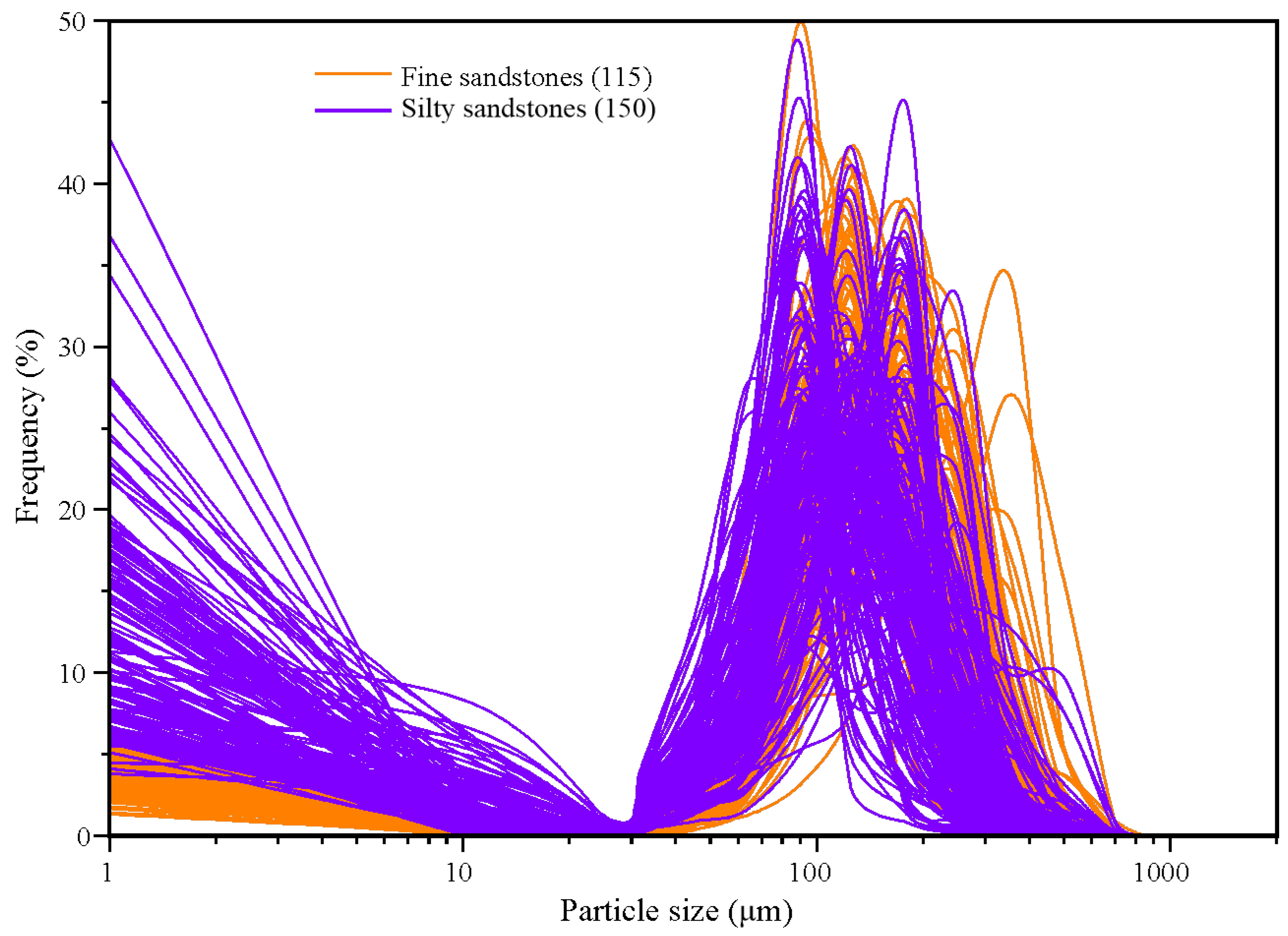
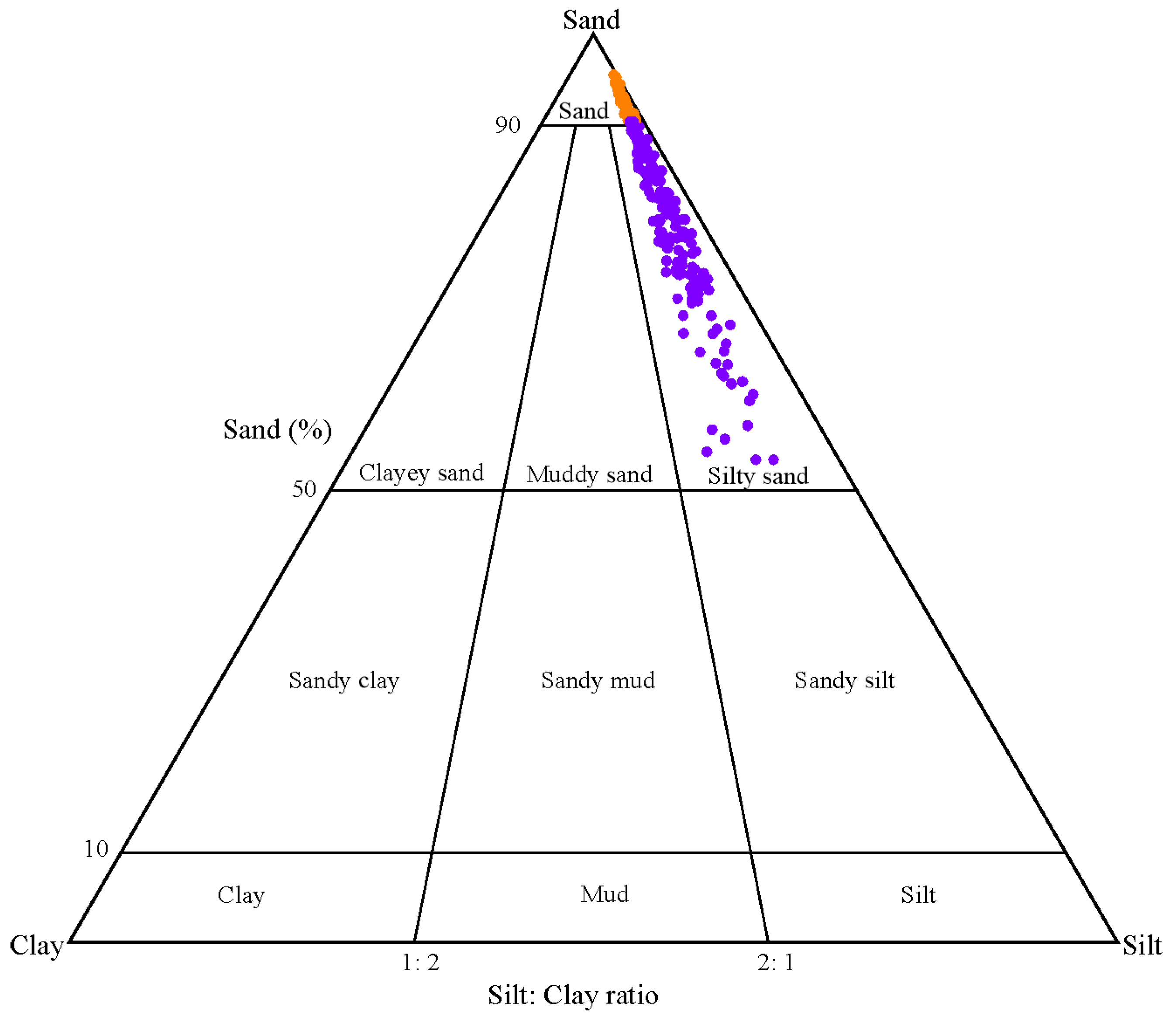
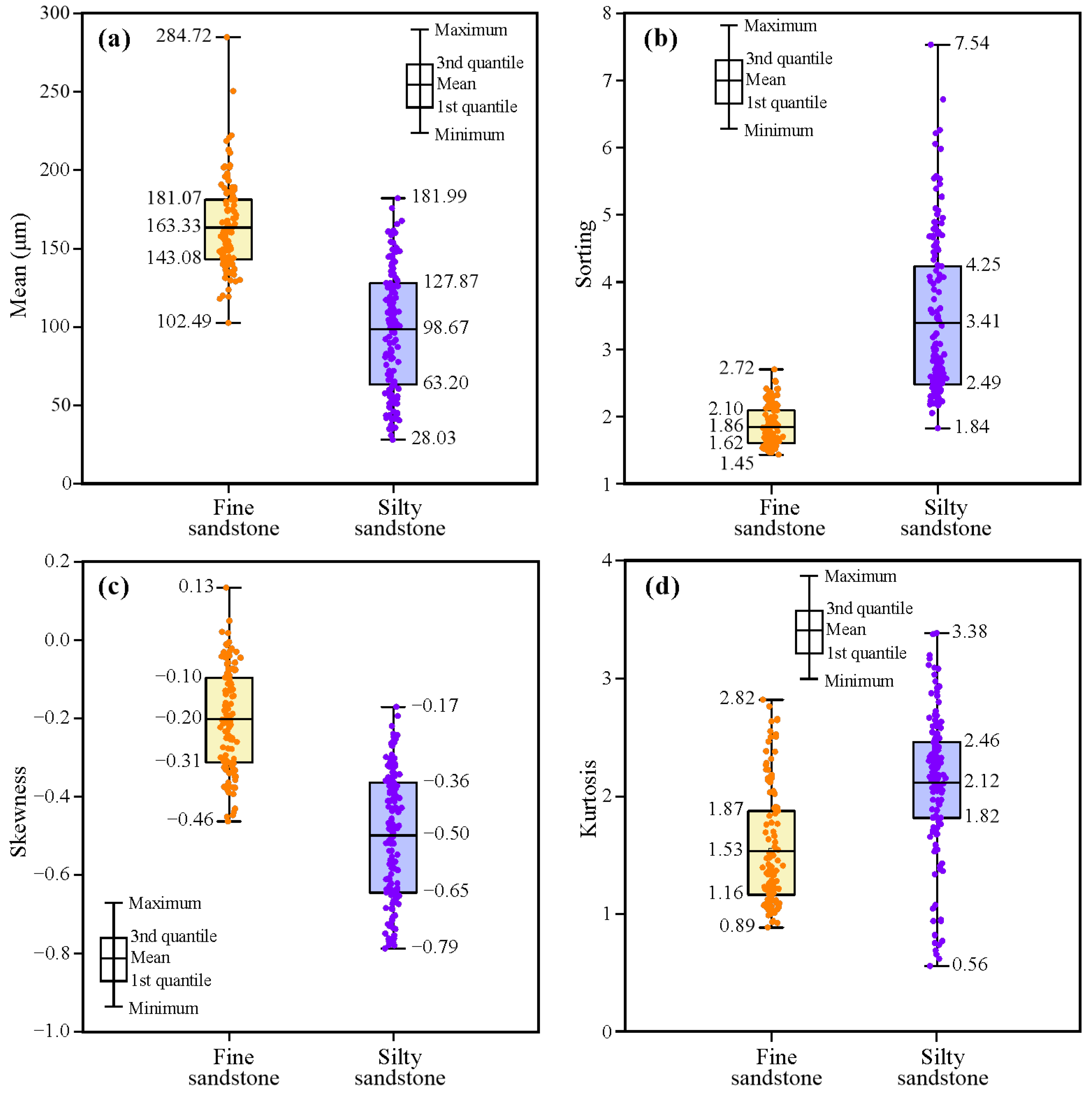

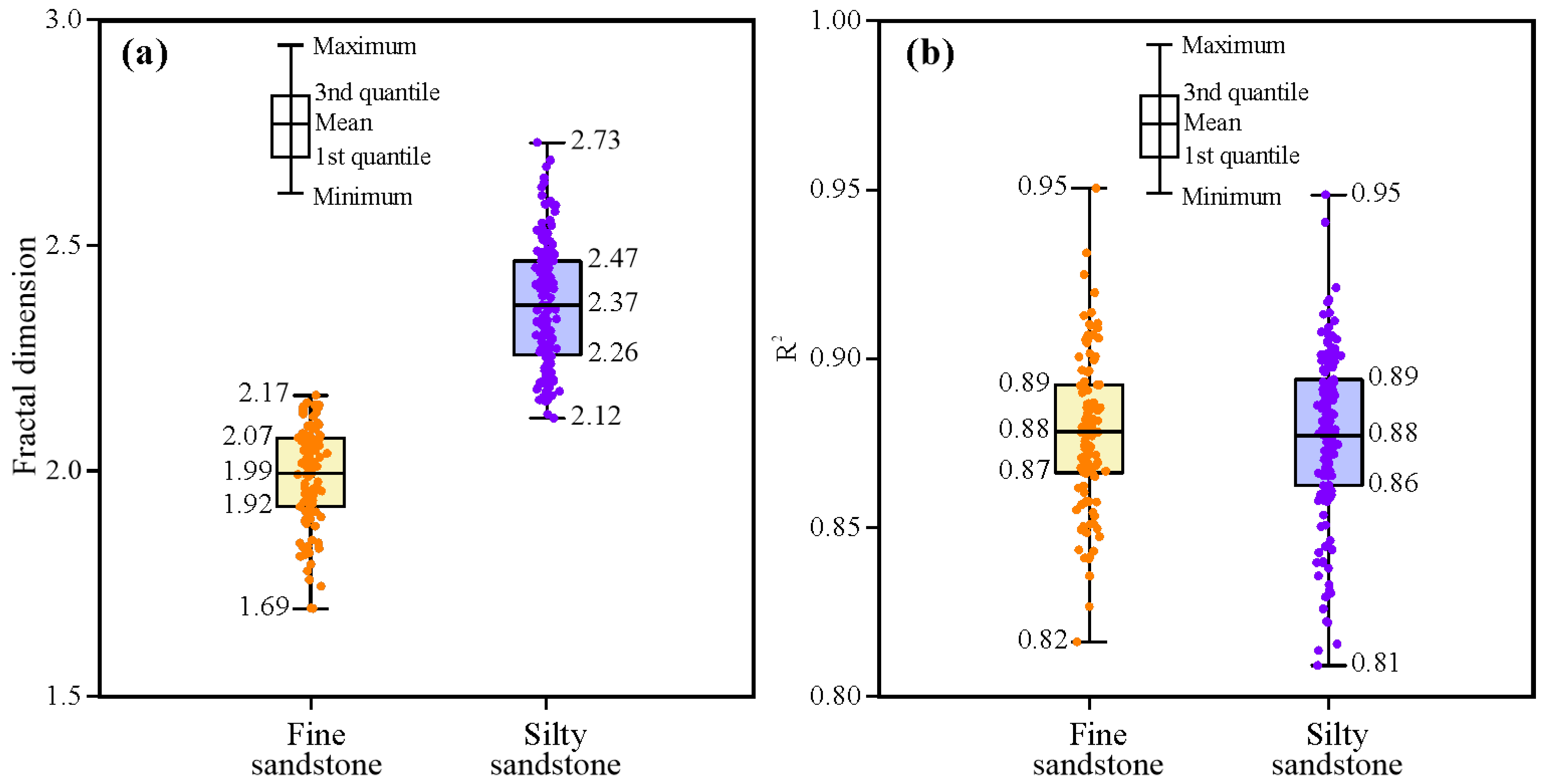
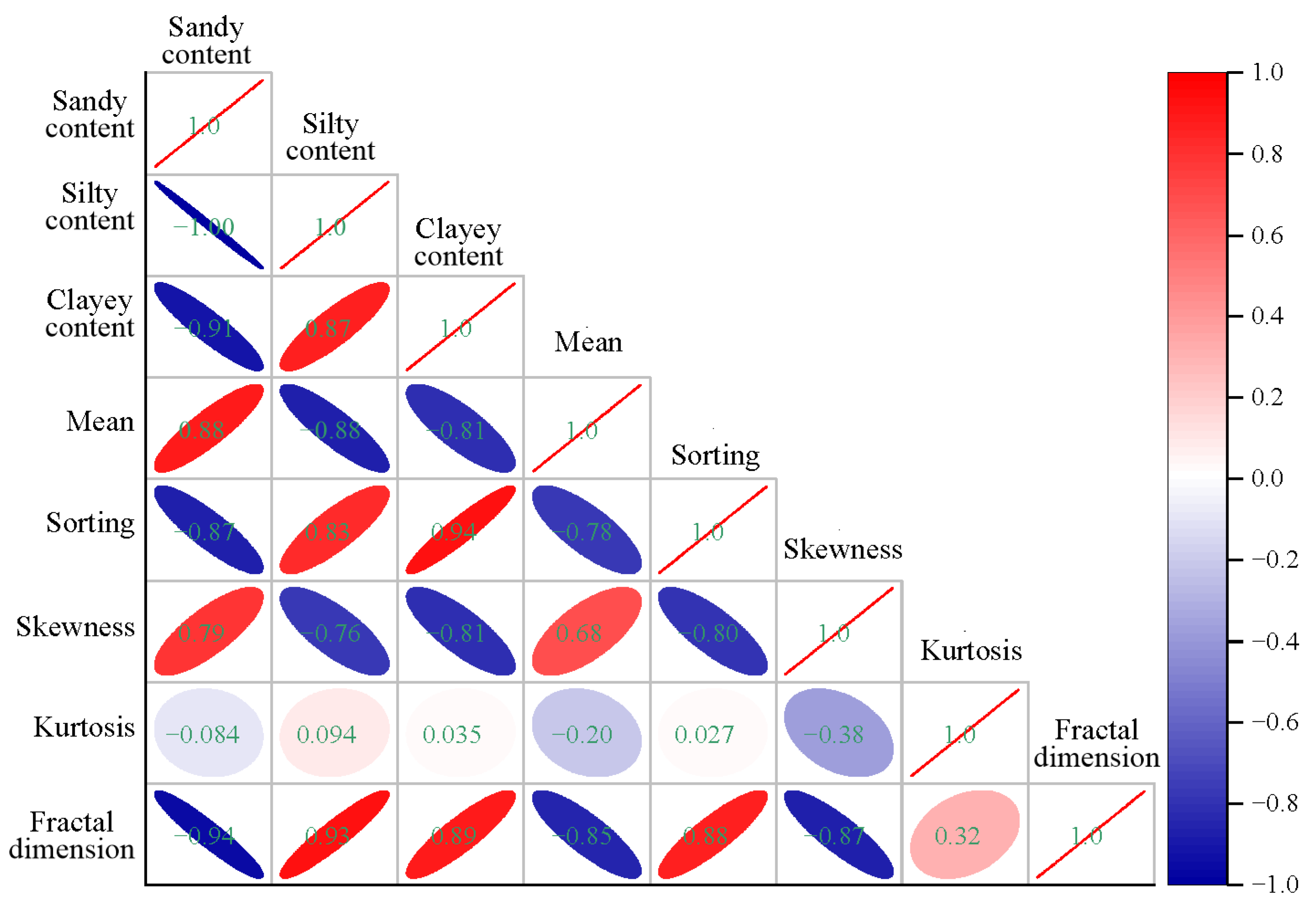


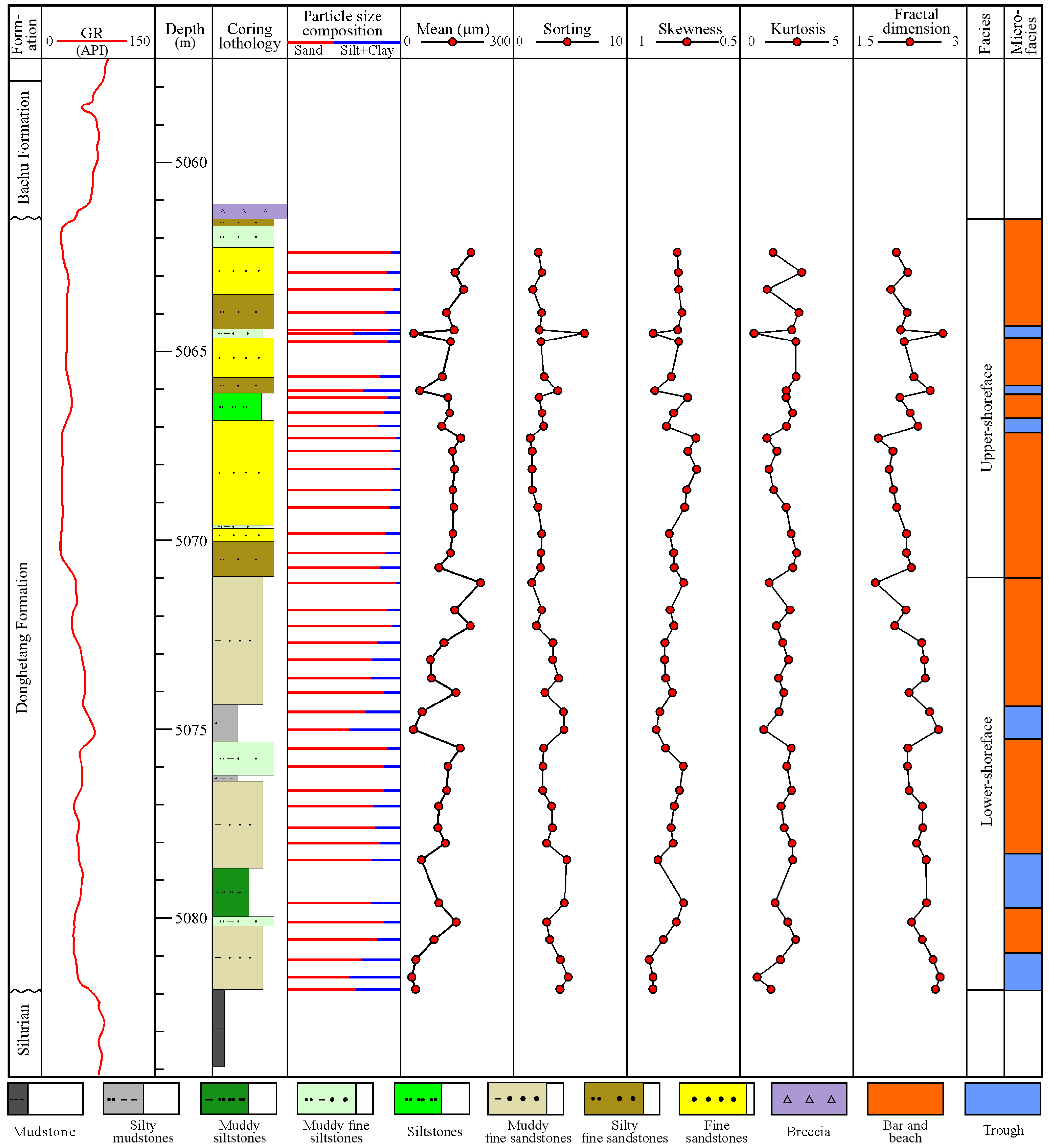

Disclaimer/Publisher’s Note: The statements, opinions and data contained in all publications are solely those of the individual author(s) and contributor(s) and not of MDPI and/or the editor(s). MDPI and/or the editor(s) disclaim responsibility for any injury to people or property resulting from any ideas, methods, instructions or products referred to in the content. |
© 2025 by the authors. Licensee MDPI, Basel, Switzerland. This article is an open access article distributed under the terms and conditions of the Creative Commons Attribution (CC BY) license (https://creativecommons.org/licenses/by/4.0/).
Share and Cite
Yuan, R.; Sun, Q.; Zhan, M.; Liu, W.; Sun, Y.; Wang, S.; Yuan, Y. Fractal Dimensions of Particle Size Distribution in Littoral Sandstones of Carboniferous Donghetang Formation in Hade Oilfield, Tarim Basin, NW China. Fractal Fract. 2025, 9, 364. https://doi.org/10.3390/fractalfract9060364
Yuan R, Sun Q, Zhan M, Liu W, Sun Y, Wang S, Yuan Y. Fractal Dimensions of Particle Size Distribution in Littoral Sandstones of Carboniferous Donghetang Formation in Hade Oilfield, Tarim Basin, NW China. Fractal and Fractional. 2025; 9(6):364. https://doi.org/10.3390/fractalfract9060364
Chicago/Turabian StyleYuan, Rui, Qi Sun, Manli Zhan, Wenlu Liu, Ye Sun, Siyi Wang, and Yufei Yuan. 2025. "Fractal Dimensions of Particle Size Distribution in Littoral Sandstones of Carboniferous Donghetang Formation in Hade Oilfield, Tarim Basin, NW China" Fractal and Fractional 9, no. 6: 364. https://doi.org/10.3390/fractalfract9060364
APA StyleYuan, R., Sun, Q., Zhan, M., Liu, W., Sun, Y., Wang, S., & Yuan, Y. (2025). Fractal Dimensions of Particle Size Distribution in Littoral Sandstones of Carboniferous Donghetang Formation in Hade Oilfield, Tarim Basin, NW China. Fractal and Fractional, 9(6), 364. https://doi.org/10.3390/fractalfract9060364





